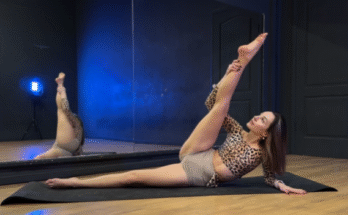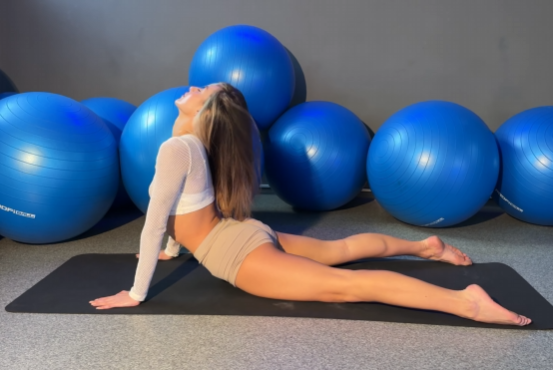
Your back is the silent pillar that supports everything you do — from bending and twisting to walking, sitting, and even breathing. Yet, it’s also one of the most neglected and overworked parts of the body. Hours of sitting, poor posture, or even emotional stress can build up layers of tension that eventually turn into stiffness, discomfort, or pain. The good news is that you can restore balance and improve flexibility with something as simple as a daily Back Stretch Routine.
This routine isn’t about pushing your limits or forcing extreme movements. It’s about listening to your body, opening space along your spine, and reawakening muscles that have been locked for too long. Whether you’re someone who sits at a desk all day, stands for hours, or leads an active lifestyle, this sequence can help you release pain, enhance mobility, and bring harmony back to your posture.
Let’s begin this gentle, restorative journey — a 1,000-word guide to relieving back pain and improving flexibility.
🌿 Step 1: Grounding the Body and Breath (1 minute)
Find a quiet space and roll out your yoga mat. Sit comfortably or lie flat on your back with your knees bent. Take a deep breath in through your nose, feeling your abdomen expand. Exhale slowly through your mouth, letting go of all tension.
This first step might seem simple, but it’s powerful. Your breath is the key to unlocking tight muscles. As you breathe deeply, your nervous system relaxes, signaling your body that it’s safe to release. Imagine your breath flowing down your spine, reaching the very base of your back, softening every vertebra.
Take 3–4 rounds of deep, mindful breathing before moving into motion.
🌺 Step 2: Cat-Cow Stretch (30 seconds)
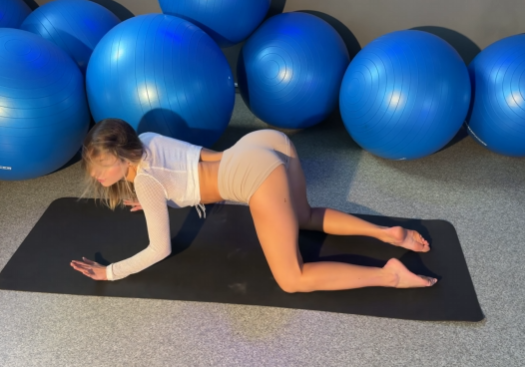
Come onto your hands and knees in a tabletop position. Align your wrists under your shoulders and your knees under your hips. Spread your fingers wide for support.
Inhale — drop your belly toward the mat, lift your head and tailbone up. Feel the stretch through your front body as your spine arches gently. This is Cow Pose.
Exhale — round your spine toward the ceiling, tuck your chin, and draw your navel inward. This is Cat Pose.
Continue moving between these two positions slowly, following your breath. Each inhale creates space; each exhale releases it.
This classic yoga flow gently warms up your spine, improves mobility, and awakens the deep core muscles that stabilize your back. After 5–6 rounds, you’ll feel your back lengthening and loosening.
🌼 Step 3: Child’s Pose (30 seconds)
From tabletop, bring your big toes together and spread your knees wide. Sit your hips back toward your heels and extend your arms forward, resting your forehead on the mat.
This Child’s Pose (Balasana) offers a deep, soothing stretch to the lower back while calming the mind.
Let your chest melt toward the floor and breathe into your lower back. With every exhale, feel your spine elongate.
You can walk your hands slightly to the right to stretch the left side of your back, and then to the left to stretch the right. This gentle lateral variation releases tension along the sides of your spine, promoting balance and mobility.
🌙 Step 4: Seated Forward Fold (45 seconds)
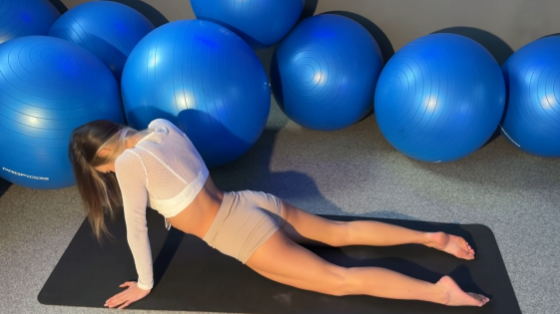
Sit up tall with your legs extended straight in front of you. Inhale deeply and raise your arms overhead, lengthening your spine. Exhale and fold forward from your hips (not your waist), reaching toward your toes.
You don’t need to touch your toes — the goal is to feel a stretch along the entire back body: your hamstrings, lower back, and shoulders.
Keep your spine long rather than rounded. Each breath brings you a little deeper, not through force but through surrender.
This pose helps decompress the spine, release tight hamstrings (which often contribute to back pain), and calm the mind.
🌸 Step 5: Supine Twist (45 seconds)
Lie down on your back and draw your right knee toward your chest. Then gently guide it across your body toward the left side, allowing your torso to twist. Extend your right arm out to the side and look toward it.
This Supine Spinal Twist gently opens the lower back, massages the internal organs, and improves spinal mobility.
Hold for 15–20 seconds, then switch sides.
Notice how your breath deepens with each twist, how the tension releases from your spine, and how your body feels more balanced afterward.
🌿 Step 6: Bridge Pose (45 seconds)

Bend your knees and place your feet flat on the floor, hip-width apart. Press your palms into the mat.
Inhale and slowly lift your hips toward the ceiling, engaging your glutes and hamstrings. Keep your shoulders grounded and your neck relaxed.
This Bridge Pose (Setu Bandhasana) strengthens your back muscles while also opening the chest and hip flexors — two areas that often cause lower back tightness when neglected.
Hold for 20–30 seconds, then exhale and slowly lower your hips back down to the mat.
Repeat this movement 2–3 times. With each lift, imagine lengthening your spine and creating more space between each vertebra.
☀️ Step 7: Knees-to-Chest Hug (30 seconds)
After Bridge Pose, draw both knees into your chest and hug them tightly. Rock gently side to side, massaging your lower back on the mat.
This simple movement helps release any lingering tightness and realigns your spine naturally.
Take deep breaths as you do this — each exhale letting go of stress, each inhale bringing in fresh energy.
🌺 Step 8: Cobra Stretch (30 seconds)
Roll over onto your stomach. Place your palms under your shoulders, elbows close to your body.
Inhale and slowly lift your chest off the ground, pressing lightly into your palms while keeping your hips grounded. Your shoulders roll back and down as your gaze lifts forward.
This is Cobra Pose (Bhujangasana) — a beautiful stretch for your spine, chest, and abdomen. It strengthens the lower back muscles and improves posture, especially if you spend long hours sitting.
Exhale and lower back down gently. Repeat 2–3 times, moving slowly and mindfully.
🌼 Step 9: Standing Forward Fold (45 seconds)
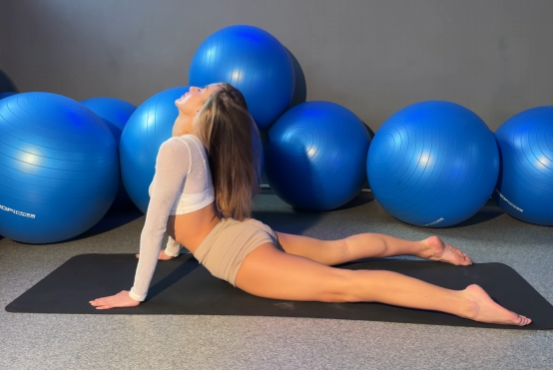
Come up to a standing position. With your feet hip-width apart, inhale and raise your arms overhead. Exhale and fold forward from your hips, letting your arms hang toward the ground.
Let your head and neck relax completely. You can bend your knees slightly if your hamstrings feel tight.
This Standing Forward Fold (Uttanasana) decompresses your spine using gravity. It allows fresh blood flow to the head and stretches your back, glutes, and hamstrings.
Stay here for several deep breaths. Feel the tension melting away.
🌙 Step 10: Gentle Back Release & Cool Down (1 minute)
To finish, return to a standing position and slowly roll your spine up, one vertebra at a time. Let your head be the last to rise.
Stand tall, take a deep breath in, and sweep your arms overhead. Exhale and bring your hands together in front of your heart.
Now, pause for a moment. Notice the lightness in your back — the warmth, the ease, the openness.
This feeling is what consistency brings: when you show up for your body every day, even for just a few minutes, you reawaken the flow of energy that keeps you strong, mobile, and pain-free.
🌻 Benefits of This Routine
When practiced regularly, this back stretch routine can transform the way your body feels and moves. Here’s how:
- Relieves stiffness from sitting or poor posture.
- Improves spinal alignment and promotes better posture.
- Reduces lower back pain caused by tight hips and hamstrings.
- Increases flexibility in the back, shoulders, and hips.
- Boosts circulation to the spine and muscles.
- Promotes relaxation, reducing stress and anxiety.
What makes this routine truly effective is its combination of dynamic and static stretches. The dynamic movements (like Cat-Cow and Bridge Pose) warm up the spine and activate supporting muscles, while the static holds (like Seated Forward Fold or Supine Twist) allow deep release and improved flexibility.
🌸 The Mind-Body Connection
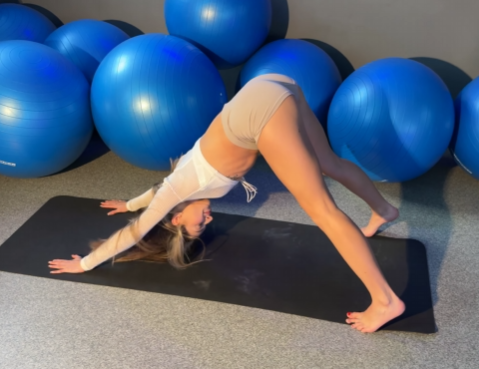
Your back holds not only physical tension but also emotional weight — stress, fatigue, even memories. When you stretch, you’re not just lengthening muscles; you’re also letting go of what’s been held too tightly inside.
Each breath, each stretch, is a small act of healing. The more you practice, the more you’ll notice that flexibility in your body brings flexibility in your mind.
So the next time you feel tension building in your back, don’t ignore it. Step onto your mat, breathe deeply, and move through this sequence.
🌅 Final Thought
Your back supports you in everything — so support it in return.
This Back Stretch Routine is your invitation to reconnect with your body, relieve pain, and rediscover the natural freedom of movement. Even ten minutes a day can make a difference.
Remember: progress is not measured by how far you can bend, but by how deeply you can feel your body.
Move with patience. Stretch with love. Breathe with awareness.
Because when your back feels free — your whole life opens up.

